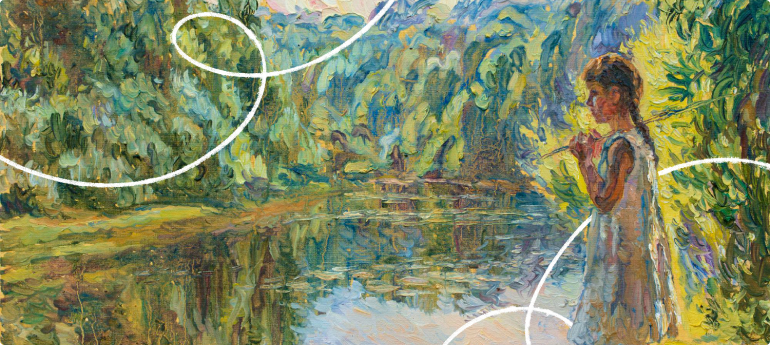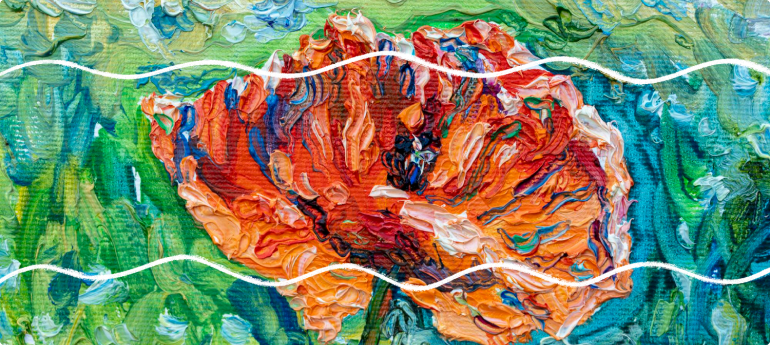In the world of visual art, a question inevitably arises: “What’s easier for bringing your ideas to life on canvas — watercolor or oil?”
Let’s explore together the features and advantages of each medium, and uncover the secrets of choosing between watercolor and oil.
Facing a dilemma? Read my article!
Watercolor art: why watercolor paintings are attractive
Mysterious transitions from one shade to another, delicate waves of color creating magic on the canvas — watercolor art is a form of enchantment capable of captivating the eye and making the heart beat faster.
This technique embodies both the fragility and the grandeur of nature.
- The foundation of watercolor painting — water. The weightless pigments dissolving in this element create amazing combinations and shades. They easily penetrate the pores of the paper, embodying veils and transitions that cannot be achieved with other painting techniques. Thus, watercolor is distinguished by its unique ability to interact with the substrate, whether it’s rough paper or smooth cardboard.
- The special magic of watercolor also lies in its ability to recreate incredible effects of light and transparency. A light wash of color can recreate the illusion of sunlight streaming through tree leaves or reflecting in crystal-clear water. Such paintings often appear as frozen moments in time, capturing the play of light and shadow.
- In watercolor art, an important place is also given to the technique of wet-on-wet brushwork. This method allows the artist to work with smooth transitions between colors, adding softness to the painting. Emotional nuances are conveyed, making the viewer feel the atmosphere of the moment depicted on the canvas.
- And, of course, accessibility. Even a beginner artist can easily learn the basics of this technique due to its delicate and accommodating nature. At the same time, experienced masters find endless creative possibilities in watercolor, evolving from simple landscapes to complex compositions.


Oil painting: why oil paintings are attractive
Oil Painting — a jewel in the crown of art history. Great masters of the past, whether it be the eternal Leonardo da Vinci or the passionate Vincent van Gogh, used this technique to capture their vision of the world.
- The magnificence of oil paints lies in their ability to recreate vivid and deep shades. From crimson-red sunsets to delicate blue skies — it is oil paints that allow the artist to immerse in the richness of color, creating a true kaleidoscope of visual pleasure on the canvas.
- Time as a witness to beauty. One of the greatest traits of oil painting is its resistance to time. Paintings created with this technique do not lose their freshness and brightness even after years. They, like magical artifacts, hold not only beauty but also the wisdom of the era, becoming a source of eternal admiration.
- The depth and realism of the image. The magical effect is achieved through multiple layers of paint, densely covering the canvas and creating an impressive illusory world. A walk through the imagination along the waterfront of a picturesque resort town or the sensation of the aroma of a pine forest depicted in a summer landscape — it feels so real thanks to oil.
- Oil is amenable to restoration. If you find an experienced master, the problem of improper storage, where the paint layer becomes covered with small cracks, can be solved. The canvas can be restored to its original beauty!

Moreover, oil paintings make a wonderful gift. They are sure to capture hearts:
- Art collectors: oil paintings attract those who appreciate the uniqueness and beauty of each piece.
- True aesthetes: for those who see in oil painting the embodiment of true art, these paintings become a unique gift filled with depth and expressiveness.
- People of all ages and professions: with a variety of genres and techniques, oil paintings cater to a broad range of human tastes and interests. An ideal gift for those seeking beauty and refinement.
Masters of the art world acknowledge that oil paintings surpass watercolors. Several factors support this noble art form.
Masterpieces of world art have been created using oil painting techniques. Great names such as Shishkin, Aivazovsky, Surikov, Monet, and Van Gogh are just a few of the artists whose unique works are closely associated with this noble technique. It is no wonder that this form of painting enjoys such widespread demand and recognition.
The main differences between watercolor and oil paints
- Base and Dilution.
Watercolor is water-based, which makes it transparent and light. On the other hand, oil paints are made with an oil base, giving them richness and depth. Watercolor is diluted with water. The artist can control the level of transparency and color saturation by adding or removing water. In oil paints, special oils or solvents are used for this purpose. - Drying Time and Layers. Watercolor dries quickly, which is especially useful for projects with tight deadlines. Oil paint, on the other hand, requires a longer drying time.
- Texture and Effects.
Oil paints allow for rich textural effects. Artists use various tools — brushes and palette knives — to add volume and depth to their paintings. Oil is an ideal choice for realistic portraits and landscapes. Watercolor, on the other hand, usually creates flatter, transparent effects and is great for light and airy compositions. - Color Intensity and Gloss.
Oil paints have a high degree of color intensity and gloss. Watercolor is characterized by more delicate and subtle hues. - Paper and Canvas.
Watercolor requires special paper that absorbs water and creates vibrant, shimmering colors. Oil is traditionally applied to canvas (which needs to be primed beforehand), giving the work durability and permanence.


When selecting paints, there are a few simple rules to follow. On the labels of each paint package, you may find special markings in the form of symbols “*” or “+”. These symbols indicate the degree of lightfastness. In simple terms, the more stars or plus signs there are, the higher the paint’s durability.
Experience shows that paints with one star (*) are prone to fading in the sun within a year, and the lifespan of the canvas is limited to 5-7 years. This material is most commonly used for creating studies, and less frequently in painting.
The most optimal choice is paint with two stars (**). A painting created with such paint will retain its color and quality for at least 25 years.
Choosing between watercolor and oil depends on the artist’s style. Each of these paints has unique characteristics, providing the creator with unlimited possibilities for self-expression.
Regardless of the choice, it’s important to remember that art is a journey during which you can discover new techniques and refine your skills.

Advantages and disadvantages of oil painting
Advantages of Oil Paints:
- Richness and Vividness of Colors: Oil paints have an amazing ability to reproduce rich and deep colors. Due to their oil base, they allow artists to work with the most intense shades.
- Slow Drying: Oil dries slowly. This gives the artist more time to focus on the details of the painting, make adjustments, and create complex textures.
- Textures and Layers: Artists can create a variety of textures and effects that are difficult to achieve with other paints. This versatility allows for intricate and multi-dimensional works.
- Durability and Color Retention: Works created with oil paints are known for their longevity and resistance to fading over time.
Disadvantages:
- Long Drying Time: The slow drying of oil paints can be both an advantage and a disadvantage. It can be problematic for artists who need to complete projects quickly, especially with time constraints.
- Toxicity of Solvents: The use of solvents in oil painting can pose health risks. In uncontrolled environments, this can lead to respiratory issues and other health problems.
- Weight and Bulkiness: Oil paintings can be cumbersome to transport and store, as they are often heavy and bulky.
- High Costs: Oil paints, brushes, canvases, and other materials can be expensive. For beginners, the cost of art supplies can be a daunting barrier to creativity.


So what should you choose?
Oil paints are a classic medium used by many great artists throughout the centuries. They are known for their rich colors, which can convey depth and volume on canvas.
Oil paints also boast a high degree of resistance to ultraviolet radiation, which allows them to maintain their brightness for many years. They are ideal for working with intricate details and subtle transitions of tones.
Of course, working with oil paints is not always easy; it requires technique and preparation. But the results are often magnificent!
On the other hand, watercolor is a lighter and more transparent medium that offers freedom and expressiveness. However, the quick drying of watercolor requires skill and precision from the artist, leaving little room for corrections.
Making a choice: if your goal is to create rich, textured works that require multiple revisions, oil paints will be your reliable ally. If you seek lightness, transparency, and speed of execution, watercolor is the way to go.
Moreover, there is nothing to stop artists from combining these two materials to create unique hybrid works where oil and watercolor complement each other in a dance of colors and forms. Modern artists’ experiments often become the key to unlocking new horizons in art.
Question-answer
Watercolors:
- Easy to use and requires less technical skill.
- Dry quickly, allowing for faster work.
- Allow for creating transparent layers and overlay effects.
- Well-suited for indoor work and small formats.
- Suitable for use on paper and cardboard.
Oil paints:
- Allow for creating deep, thin layers and textures.
- Require skills in color mixing and application techniques.
- Dry slowly, allowing for modifications over an extended period.
- Have rich colors and realistic tones.
- More expensive and require the use of solvents and special brushes.
If you are a beginner artist, watercolor might be a better choice as it is easier to use and requires less skill (just be careful!).
However, if you are interested in oil paints and ready to learn new techniques, oil paints can also be a good choice.
- More options for idea execution: Oil paints allow artists to create a broader range of effects in their work. Oil can be applied in thick layers to create textured effects or thinned to recreate transparent and light hues.
- Bright and rich colors: Oil paints offer better color saturation and depth of texture.
- Durability and color retention: Typically, oil paintings retain their rich colors and brightness for many generations. This factor has made oil painting more popular among collectors and artists.
- Corrections: Oil allows artists to make changes and adjustments to their work even after the painting process is completed. This ability to repaint and modify the artwork over time provides artists with greater freedom and flexibility in their creativity.




